TOYOTA RAV4 HYBRID 2020 Warranties & Maintenance Guides (in English)
Manufacturer: TOYOTA, Model Year: 2020, Model line: RAV4 HYBRID, Model: TOYOTA RAV4 HYBRID 2020Pages: 260, PDF Size: 8.54 MB
Page 141 of 260
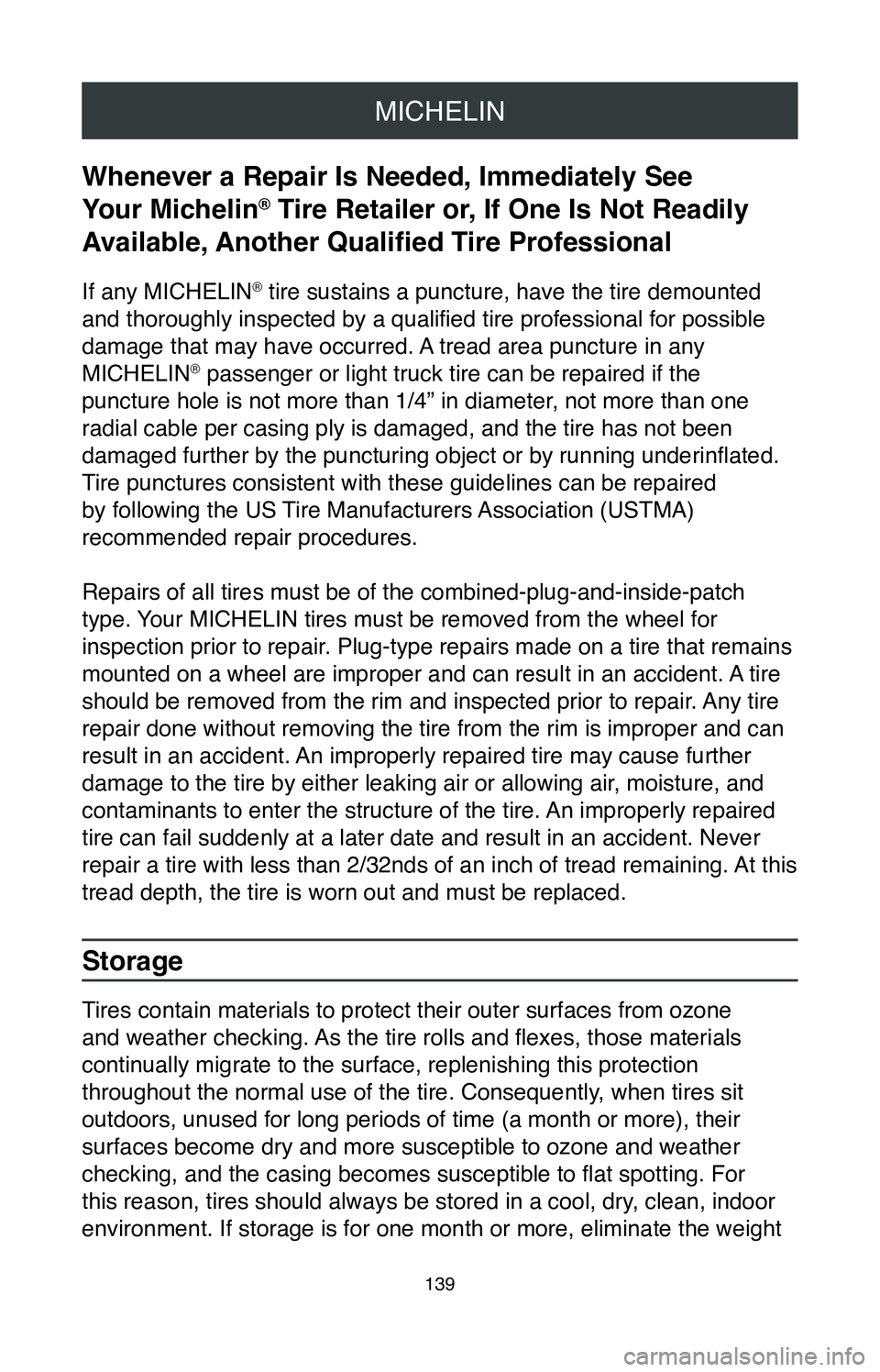
MICHELIN
139
Whenever a Repair Is Needed, Immediately See
Your Michelin
® Tire Retailer or, If One Is Not Readily
Available, Another Qualified Tire Professional
If any MICHELIN® tire sustains a puncture, have the tire demounted
and thoroughly inspected by a qualified tire professional for possible
damage that may have occurred. A tread area puncture in any
MICHELIN
® passenger or light truck tire can be repaired if the
puncture hole is not more than 1/4” in diameter, not more than one
radial cable per casing ply is damaged, and the tire has not been
damaged further by the puncturing object or by running underinflated.
Tire punctures consistent with these guidelines can be repaired
by following the US Tire Manufacturers Association (USTMA)
recommended repair procedures.
Repairs of all tires must be of the combined-plug-and-inside-patch
type. Your MICHELIN tires must be removed from the wheel for
inspection prior to repair. Plug-type repairs made on a tire that remains
mounted on a wheel are improper and can result in an accident. A tire
should be removed from the rim and inspected prior to repair. Any tire
repair done without removing the tire from the rim is improper and can
result in an accident. An improperly repaired tire may cause further
damage to the tire by either leaking air or allowing air, moisture, and
contaminants to enter the structure of the tire. An improperly repaired
tire can fail suddenly at a later date and result in an accident. Never \
repair a tire with less than 2/32nds of an inch of tread remaining. At this
tread depth, the tire is worn out and must be replaced.
Storage
Tires contain materials to protect their outer surfaces from ozone
and weather checking. As the tire rolls and flexes, those materials
continually migrate to the surface, replenishing this protection
throughout the normal use of the tire. Consequently, when tires sit
outdoors, unused for long periods of time (a month or more), their
surfaces become dry and more susceptible to ozone and weather
checking, and the casing becomes susceptible to flat spotting. For
this reason, tires should always be stored in a cool, dry, clean, indoor
environment. If storage is for one month or more, eliminate the weight
Page 142 of 260
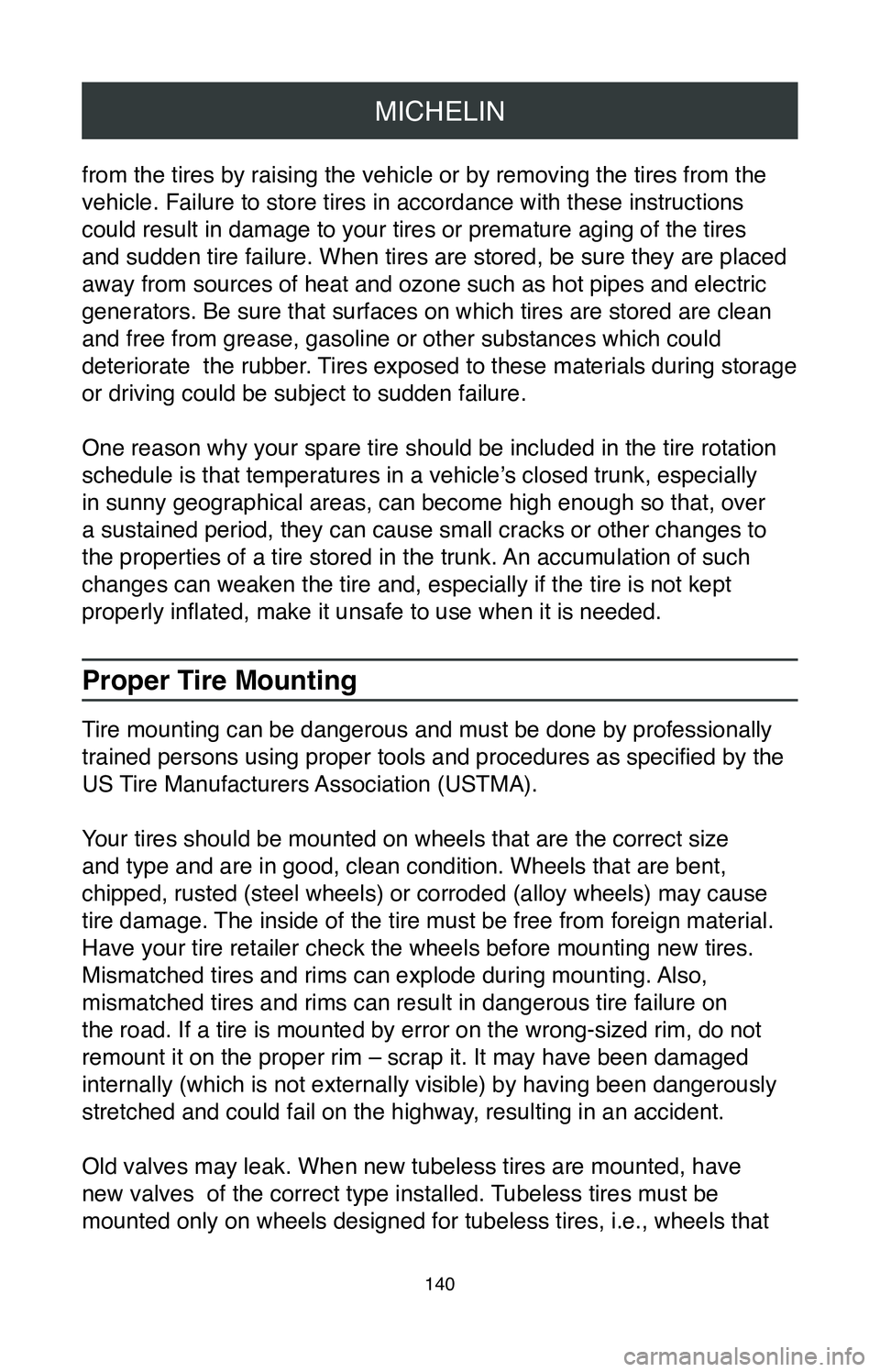
MICHELIN
140
from the tires by raising the vehicle or by removing the tires from the \
vehicle. Failure to store tires in accordance with these instructions
could result in damage to your tires or premature aging of the tires
and sudden tire failure. When tires are stored, be sure they are placed \
away from sources of heat and ozone such as hot pipes and electric
generators. Be sure that surfaces on which tires are stored are clean
and free from grease, gasoline or other substances which could
deteriorate the rubber. Tires exposed to these materials during storage
or driving could be subject to sudden failure.
One reason why your spare tire should be included in the tire rotation
schedule is that temperatures in a vehicle’s closed trunk, especially
in sunny geographical areas, can become high enough so that, over
a sustained period, they can cause small cracks or other changes to
the properties of a tire stored in the trunk. An accumulation of such
changes can weaken the tire and, especially if the tire is not kept
properly inflated, make it unsafe to use when it is needed.
Proper Tire Mounting
Tire mounting can be dangerous and must be done by professionally
trained persons using proper tools and procedures as specified by the
US Tire Manufacturers Association (USTMA).
Your tires should be mounted on wheels that are the correct size
and type and are in good, clean condition. Wheels that are bent,
chipped, rusted (steel wheels) or corroded (alloy wheels) may cause
tire damage. The inside of the tire must be free from foreign material.
Have your tire retailer check the wheels before mounting new tires.
Mismatched tires and rims can explode during mounting. Also,
mismatched tires and rims can result in dangerous tire failure on
the road. If a tire is mounted by error on the wrong-sized rim, do not
remount it on the proper rim – scrap it. It may have been damaged
internally (which is not externally visible) by having been dangerously
stretched and could fail on the highway, resulting in an accident.
Old valves may leak. When new tubeless tires are mounted, have
new valves of the correct type installed. Tubeless tires must be
mounted only on wheels designed for tubeless tires, i.e., wheels that
Page 143 of 260
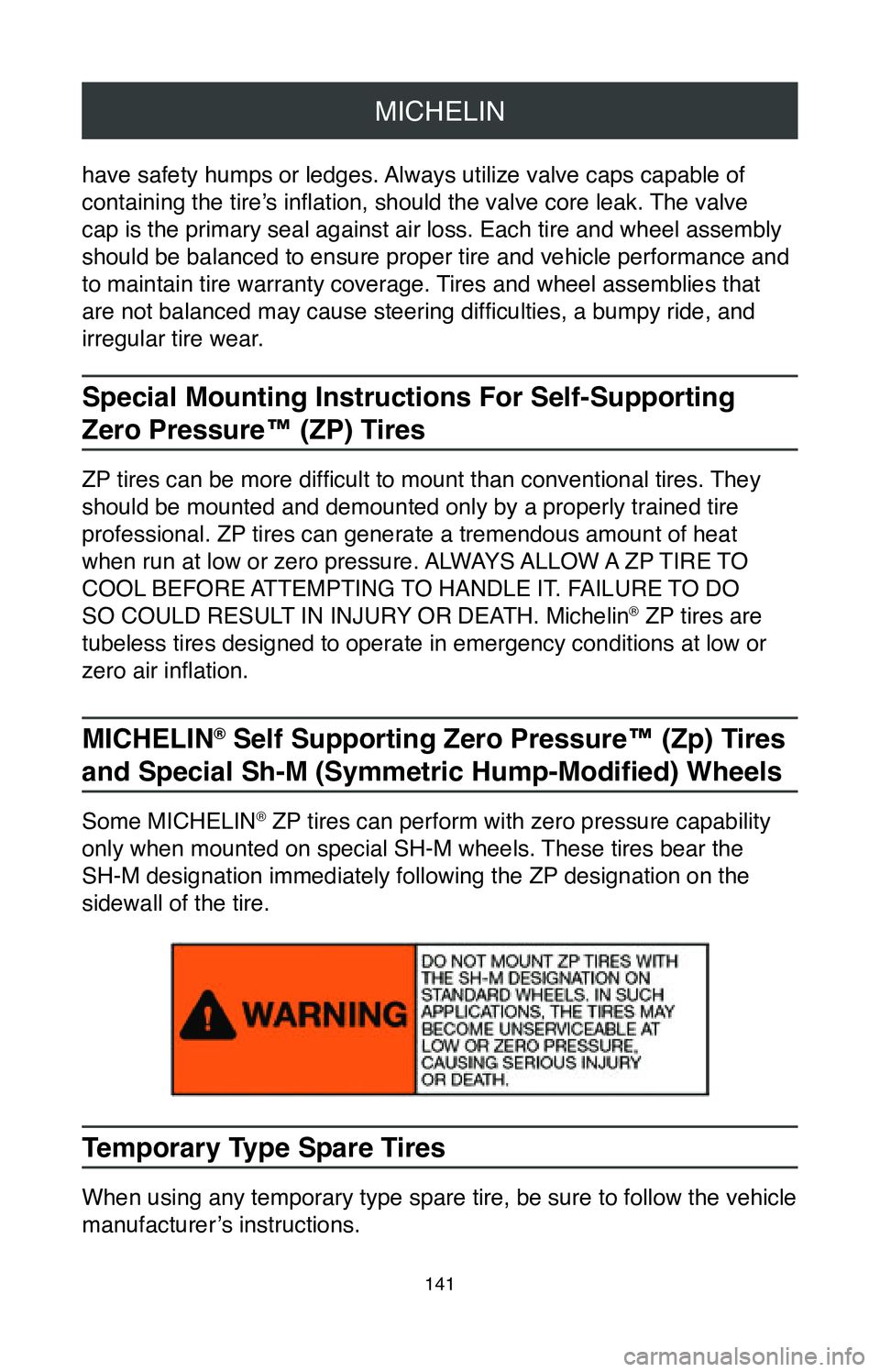
MICHELIN
141
have safety humps or ledges. Always utilize valve caps capable of
containing the tire’s inflation, should the valve core leak. The valve
cap is the primary seal against air loss. Each tire and wheel assembly
should be balanced to ensure proper tire and vehicle performance and
to maintain tire warranty coverage. Tires and wheel assemblies that
are not balanced may cause steering difficulties, a bumpy ride, and
irregular tire wear.
Special Mounting Instructions For Self-Supporting
Zero Pressure™ (ZP) Tires
ZP tires can be more difficult to mount than conventional tires. They
should be mounted and demounted only by a properly trained tire
professional. ZP tires can generate a tremendous amount of heat
when run at low or zero pressure. ALWAYS ALLOW A ZP TIRE TO
COOL BEFORE ATTEMPTING TO HANDLE IT. FAILURE TO DO
SO COULD RESULT IN INJURY OR DEATH. Michelin
® ZP tires are
tubeless tires designed to operate in emergency conditions at low or
zero air inflation.
MICHELIN® Self Supporting Zero Pressure™ (Zp) Tires
and Special Sh-M (Symmetric Hump-Modified) Wheels
Some MICHELIN® ZP tires can perform with zero pressure capability
only when mounted on special SH-M wheels. These tires bear the
SH-M designation immediately following the ZP designation on the
sidewall of the tire.
Temporary Type Spare Tires
When using any temporary type spare tire, be sure to follow the vehicle \
manufacturer’s instructions.
Page 144 of 260
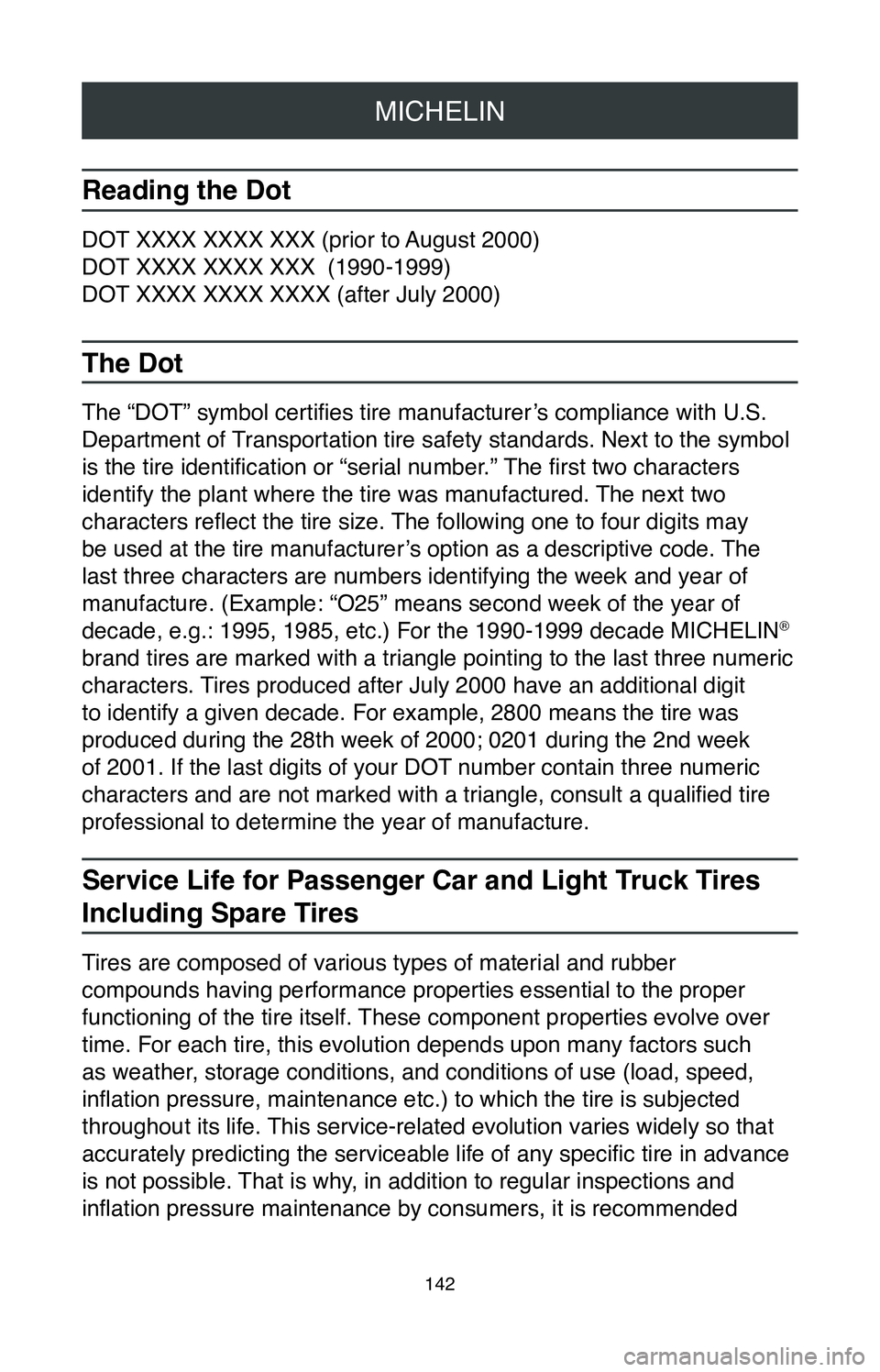
MICHELIN
142
Reading the Dot
DOT XXXX XXXX XXX (prior to August 2000)
DOT XXXX XXXX XXX
(1990-1999)
DOT XXXX XXXX XXXX (after July 2000)
The Dot
The “DOT” symbol certifies tire manufacturer’s compliance with U.S.
Department of Transportation tire safety standards. Next to the symbol
is the tire identification or “serial number.” The first two characters
identify the plant where the tire was manufactured. The next two
characters reflect the tire size. The following one to four digits may
be used at the tire manufacturer’s option as a descriptive code. The
last three characters are numbers identifying the week and year of
manufacture. (Example: “O25” means second week of the year of
decade, e.g.: 1995, 1985, etc.) For the 1990-1999 decade MICHELIN
®
brand tires are marked with a triangle pointing to the last three numeri\
c
characters. Tires produced after July 2000 have an additional digit
to identify a given decade. For example, 2800 means the tire was
produced during the 28th week of 2000; 0201 during the 2nd week
of 2001. If the last digits of your DOT number contain three numeric
characters and are not marked with a triangle, consult a qualified tire
professional to determine the year of manufacture.
Service Life for Passenger Car and Light Truck Tires
Including Spare Tires
Tires are composed of various types of material and rubber
compounds having performance properties essential to the proper
functioning of the tire itself. These component properties evolve over
time. For each tire, this evolution depends upon many factors such
as weather, storage conditions, and conditions of use (load, speed,
inflation pressure, maintenance etc.) to which the tire is subjected
throughout its life. This service-related evolution varies widely so that
accurately predicting the serviceable life of any specific tire in advance
is not possible. That is why, in addition to regular inspections and
inflation pressure maintenance by consumers, it is recommended
Page 145 of 260
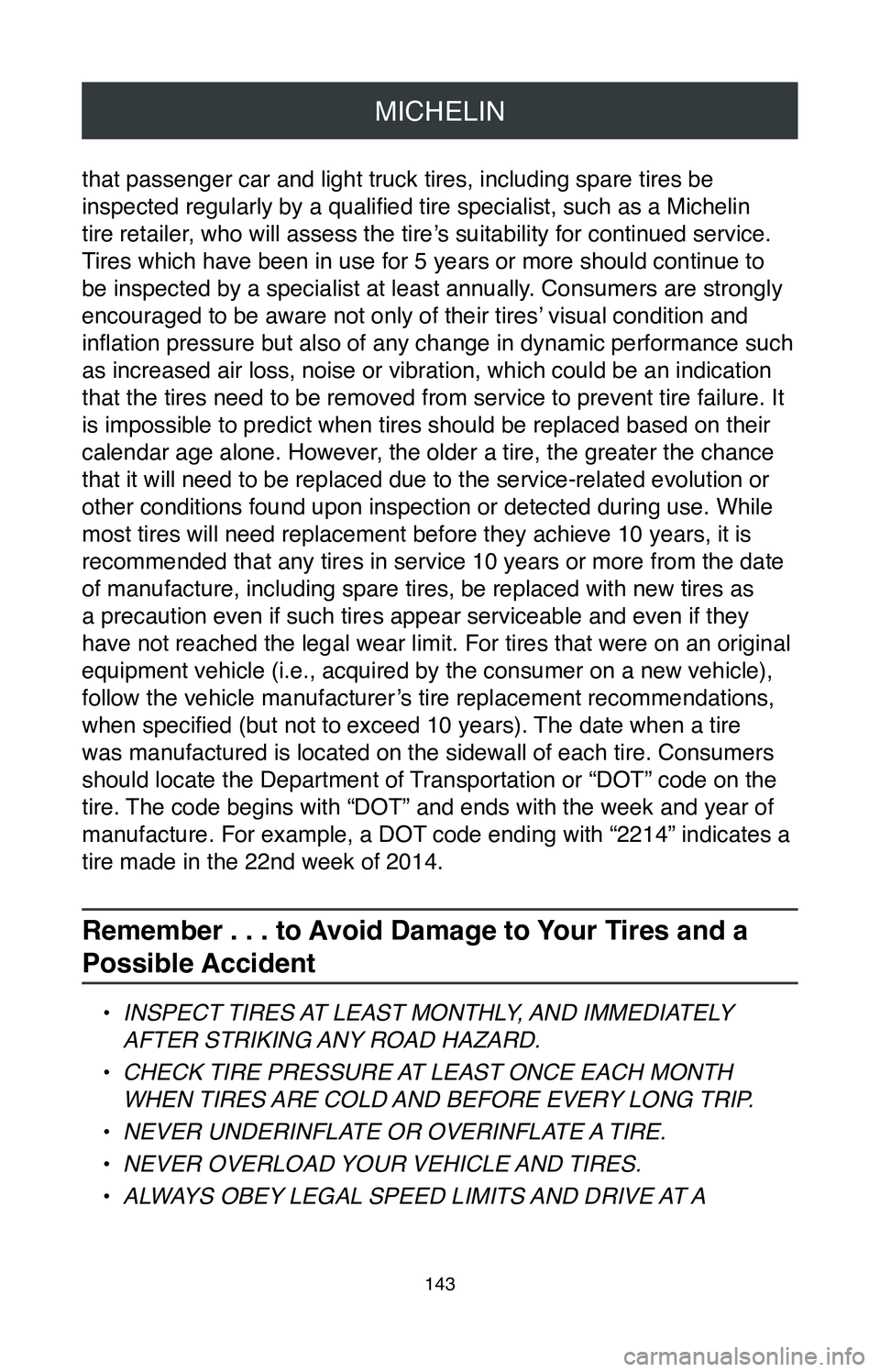
MICHELIN
143
that passenger car and light truck tires, including spare tires be
inspected regularly by a qualified tire specialist, such as a Michelin
tire retailer, who will assess the tire’s suitability for continued service.
Tires which have been in use for 5 years or more should continue to
be inspected by a specialist at least annually. Consumers are strongly
encouraged to be aware not only of their tires’ visual condition and
inflation pressure but also of any change in dynamic performance such
as increased air loss, noise or vibration, which could be an indication \
that the tires need to be removed from service to prevent tire failure. \
It
is impossible to predict when tires should be replaced based on their
calendar age alone. However, the older a tire, the greater the chance
that it will need to be replaced due to the service-related evolution or
other conditions found upon inspection or detected during use. While
most tires will need replacement before they achieve 10 years, it is
recommended that any tires in service 10 years or more from the date
of manufacture, including spare tires, be replaced with new tires as
a precaution even if such tires appear serviceable and even if they
have not reached the legal wear limit. For tires that were on an origina\
l
equipment vehicle (i.e., acquired by the consumer on a new vehicle),
follow the vehicle manufacturer’s tire replacement recommendations,
when specified (but not to exceed 10 years). The date when a tire
was manufactured is located on the sidewall of each tire. Consumers
should locate the Department of Transportation or “DOT” code on the
tire. The code begins with “DOT” and ends with the week and year of
manufacture. For example, a DOT code ending with “2214” indicates a
tire made in the 22nd week of 2014.
Remember . . . to Avoid Damage to Your Tires and a
Possible Accident
• INSPECT TIRES AT LEAST MONTHLY, AND IMMEDIATELY
AFTER STRIKING ANY ROAD HAZARD.
•
CHECK TIRE PRESSURE AT LEAST ONCE EACH MONTH
WHEN TIRES ARE COLD AND BEFORE EVERY LONG TRIP.
•
NEVER UNDERINFLATE OR OVERINFLATE A TIRE.
•
NEVER OVERLOAD YOUR VEHICLE AND TIRES.
•
ALWAYS OBEY LEGAL SPEED LIMITS AND DRIVE AT A
Page 146 of 260
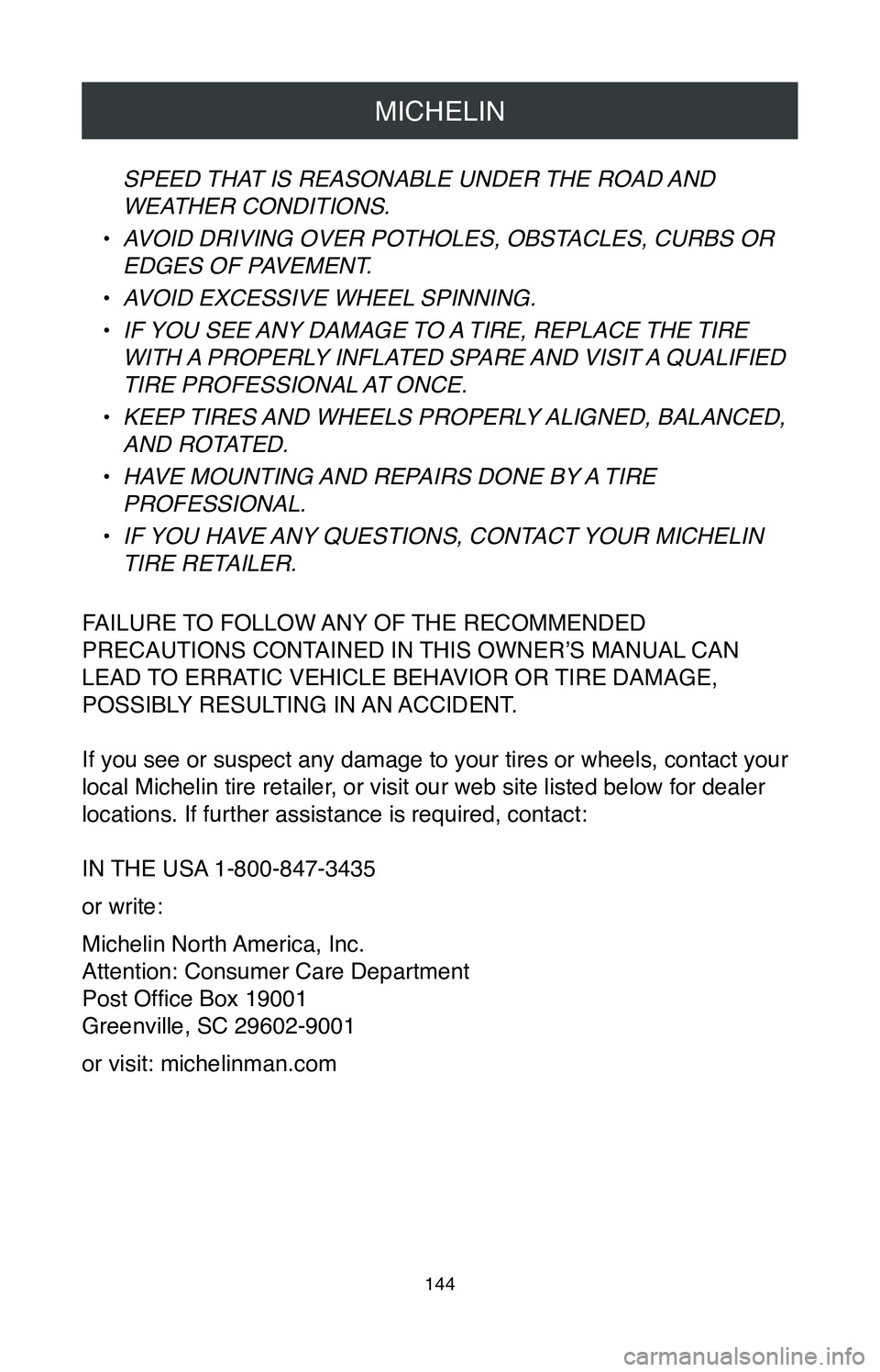
MICHELIN
144
SPEED THAT IS REASONABLE UNDER THE ROAD AND
WEATHER CONDITIONS.
•
AVOID DRIVING OVER POTHOLES, OBSTACLES, CURBS OR
EDGES OF PAVEMENT.
•
AVOID EXCESSIVE WHEEL SPINNING.
•
IF YOU SEE ANY DAMAGE TO A TIRE, REPLACE THE TIRE
WITH A PROPERLY INFLATED SPARE AND VISIT A QUALIFIED
TIRE PROFESSIONAL AT ONCE.
•
KEEP TIRES AND WHEELS PROPERLY ALIGNED, BALANCED,
AND ROTATED.
•
HAVE MOUNTING AND REPAIRS DONE BY A TIRE
PROFESSIONAL.
•
IF YOU HAVE ANY QUESTIONS, CONTACT YOUR MICHELIN
TIRE RETAILER.
FAILURE TO FOLLOW ANY OF THE RECOMMENDED
PRECAUTIONS CONTAINED IN THIS OWNER’S MANUAL CAN
LEAD TO ERRATIC VEHICLE BEHAVIOR OR TIRE DAMAGE,
POSSIBLY RESULTING IN AN ACCIDENT.
If you see or suspect any damage to your tires or wheels, contact your
local Michelin tire retailer, or visit our web site listed below for dealer
locations. If further assistance is required, contact:
IN THE USA 1-800-847-3435
or write:
Michelin North America, Inc.
Attention: Consumer Care Department
Post Office Box 19001
Greenville, SC 29602-9001
or visit: michelinman.com
Page 147 of 260
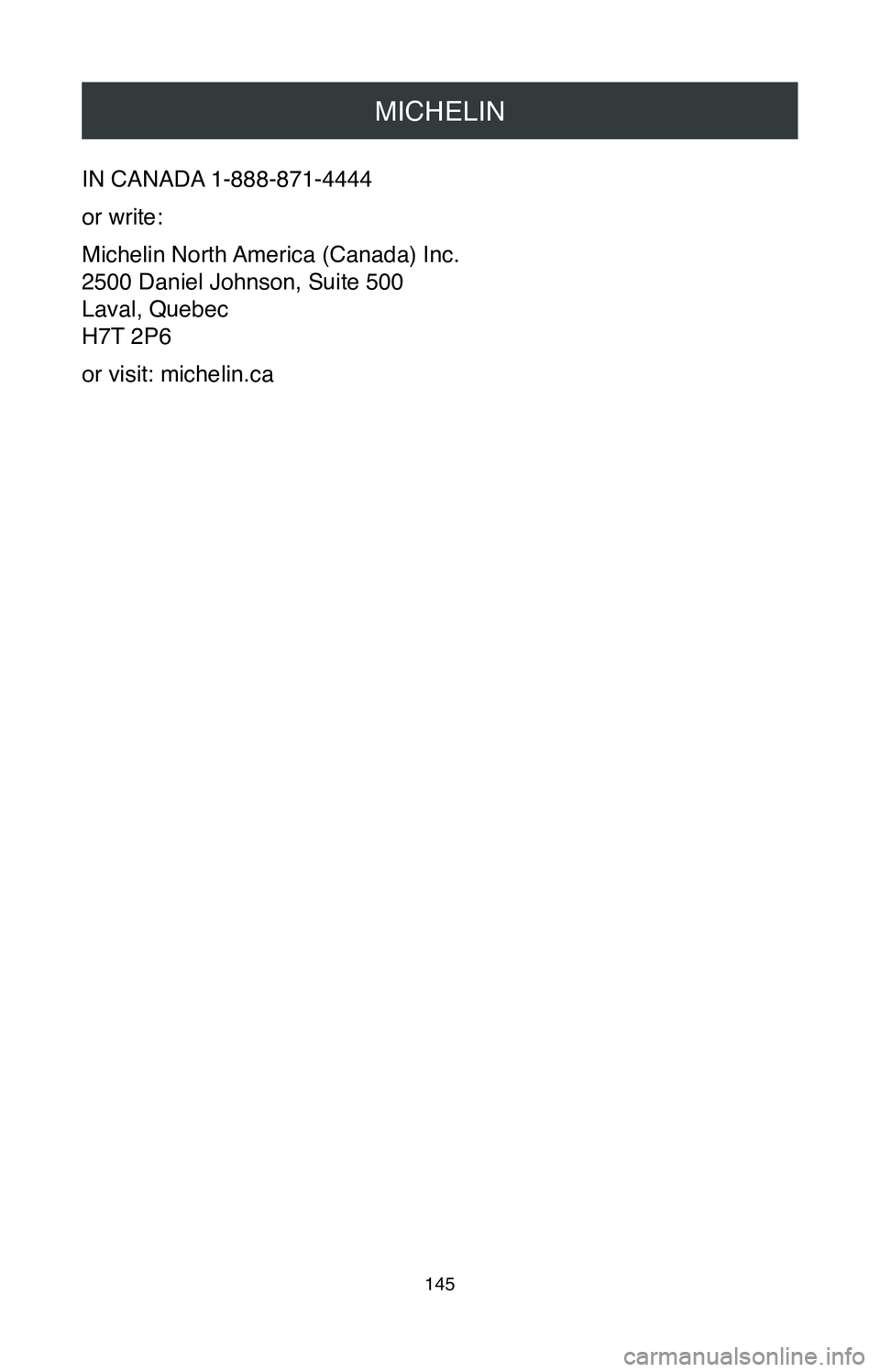
MICHELIN
145
IN CANADA 1-888-871-4444
or write:
Michelin North America (Canada) Inc.
2500 Daniel Johnson, Suite 500
Laval, Quebec
H7T 2P6
or visit: michelin.ca
Page 148 of 260
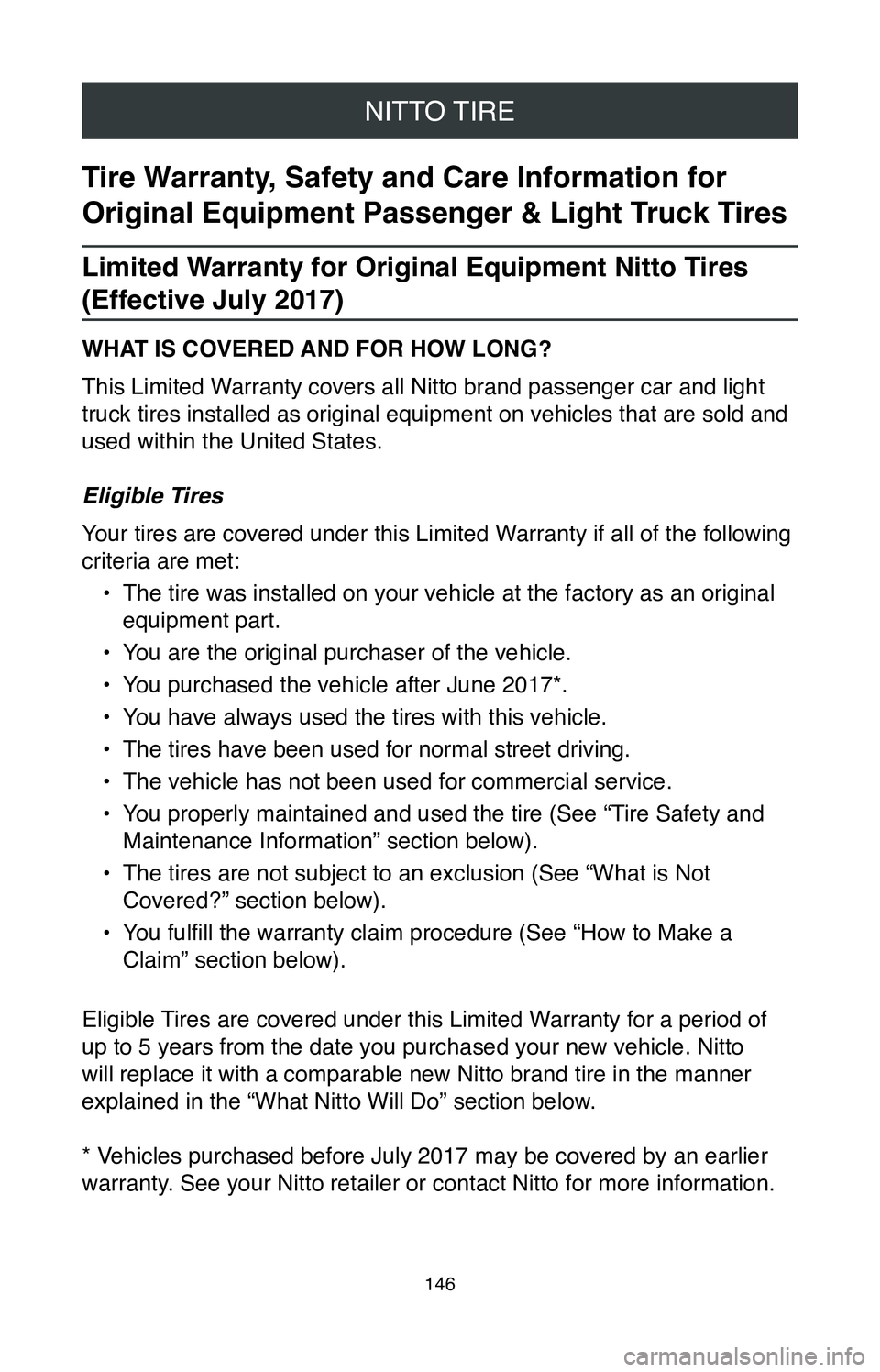
NITTO TIRE
146
Tire Warranty, Safety and Care Information for
Original Equipment Passenger & Light Truck Tires
Limited Warranty for Original Equipment Nitto Tires
(Effective July 2017)
WHAT IS COVERED AND FOR HOW LONG?
This Limited Warranty covers all Nitto brand passenger car and light
truck tires installed as original equipment on vehicles that are sold an\
d
used within the United States.
Eligible Tires
Your tires are covered under this Limited Warranty if all of the following
criteria are met:•
The tire was installed on your vehicle at the factory as an original
equipment part.
•
You are the original purchaser of the vehicle.
•
You purchased the vehicle after June 2017*.
•
You have always used the tires with this vehicle.
•
The tires have been used for normal street driving.
•
The vehicle has not been used for commercial service.
•
You properly maintained and used the tire (See “Tire Safety and
Maintenance Information” section below).
•
The tires are not subject to an exclusion (See “What is Not
Covered?” section below).
•
You fulfill the warranty claim procedure (See “How to Make a
Claim” section below).
Eligible Tires are covered under this Limited Warranty for a period of
up to 5 years from the date you purchased your new vehicle. Nitto
will replace it with a comparable new Nitto brand tire in the manner
explained in the “What Nitto Will Do” section below.
* Vehicles purchased before July 2017 may be covered by an earlier
warranty. See your Nitto retailer or contact Nitto for more information.
Page 149 of 260
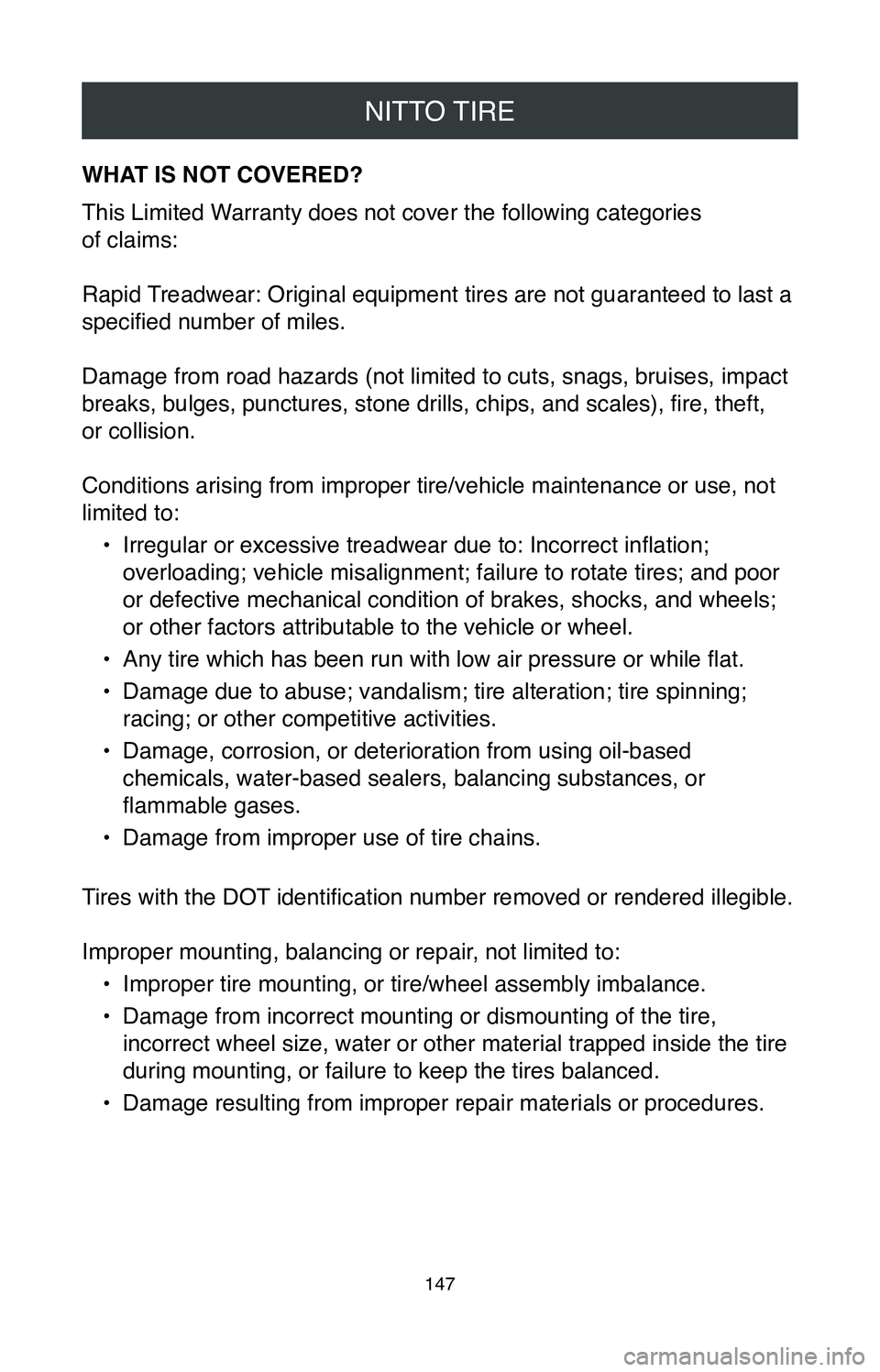
NITTO TIRE
147
WHAT IS NOT COVERED?
This Limited Warranty does not cover the following categories
of claims:
Rapid Treadwear: Original equipment tires are not guaranteed to last a
specified number of miles.
Damage from road hazards (not limited to cuts, snags, bruises, impact
breaks, bulges, punctures, stone drills, chips, and scales), fire, theft,
or collision.
Conditions arising from improper tire/vehicle maintenance or use, not
limited to:
•
Irregular or excessive treadwear due to: Incorrect inflation;
overloading; vehicle misalignment; failure to rotate tires; and poor
or defective mechanical condition of brakes, shocks, and wheels;
or other factors attributable to the vehicle or wheel.
•
Any tire which has been run with low air pressure or while flat.
•
Damage due to abuse; vandalism; tire alteration; tire spinning;
racing; or other competitive activities.
•
Damage, corrosion, or deterioration from using oil-based
chemicals, water-based sealers, balancing substances, or
flammable gases.
•
Damage from improper use of tire chains.
Tires with the DOT identification number removed or rendered illegible.
Improper mounting, balancing or repair, not limited to: •
Improper tire mounting, or tire/wheel assembly imbalance.
•
Damage from incorrect mounting or dismounting of the tire,
incorrect wheel size, water or other material trapped inside the tire
during mounting, or failure to keep the tires balanced.
•
Damage resulting from improper repair materials or procedures.
Page 150 of 260
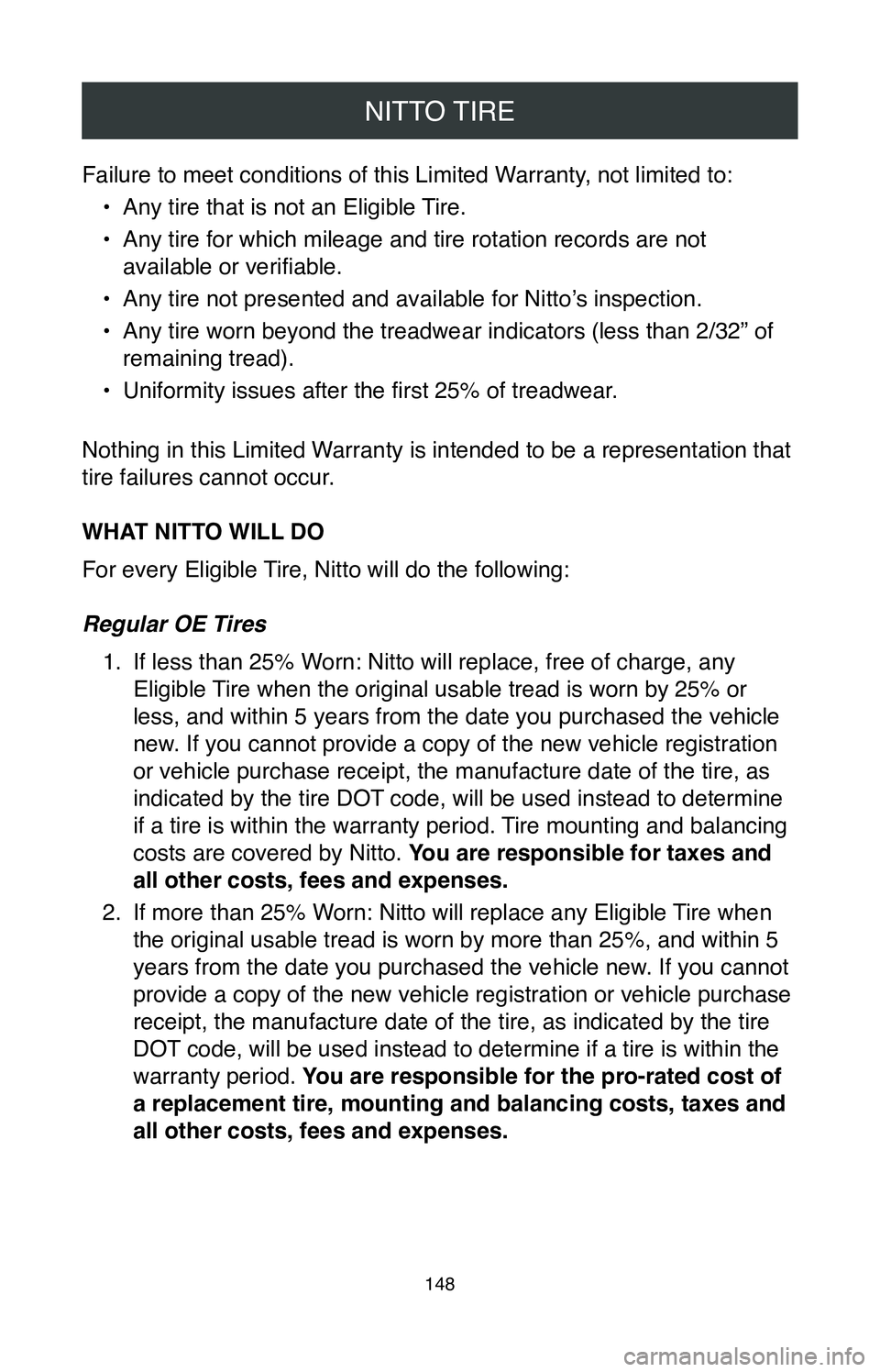
NITTO TIRE
148
Failure to meet conditions of this Limited Warranty, not limited to:•
Any tire that is not an Eligible Tire.
•
Any tire for which mileage and tire rotation records are not
available or verifiable.
•
Any tire not presented and available for Nitto’s inspection.
•
Any tire worn beyond the treadwear indicators (less than 2/32” of
remaining tread).
•
Uniformity issues after the first 25% of treadwear.
Nothing in this Limited Warranty is intended to be a representation that
tire failures cannot occur.
WHAT NITTO WILL DO
For every Eligible Tire, Nitto will do the following:
Regular OE Tires 1.
If less than 25% Worn: Nitto will replace, free of charge, any
Eligible Tire when the original usable tread is worn by 25% or
less, and within 5 years from the date you purchased the vehicle
new. If you cannot provide a copy of the new vehicle registration
or vehicle purchase receipt, the manufacture date of the tire, as
indicated by the tire DOT code, will be used instead to determine
if a tire is within the warranty period. Tire mounting and balancing
costs are covered by Nitto. You are responsible for taxes and
all other costs, fees and expenses.
2.
If more than 25% Worn: Nitto will replace any Eligible Tire when
the original usable tread is worn by more than 25%, and within 5
years from the date you purchased the vehicle new. If you cannot
provide a copy of the new vehicle registration or vehicle purchase
receipt, the manufacture date of the tire, as indicated by the tire
DOT code, will be used instead to determine if a tire is within the
warranty period. You are responsible for the pro-rated cost of
a replacement tire, mounting and balancing costs, taxes and
all other costs, fees and expenses.